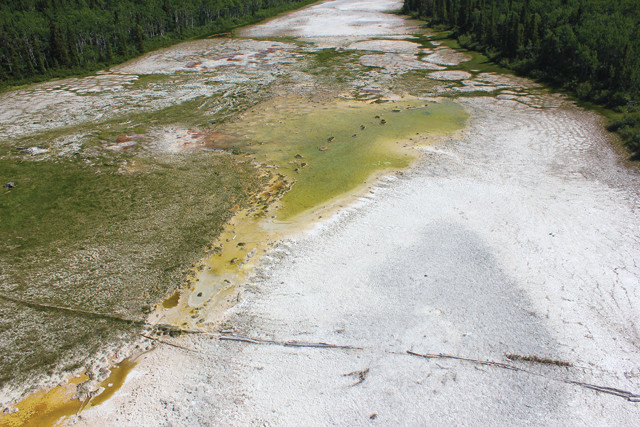
by Timothy Oleson Thursday, January 17, 2019
Left undisturbed, carbonate minerals can naturally lock up carbon in a stable form for millions of years or longer. Triggering the formation of carbonate minerals is thus a promising means of removing and sequestering carbon dioxide from the atmosphere. In recent research, scientists uncovered new details about how one of Earth’s most stable, albeit slow-to-form, carbonates — magnesite — grows in nature and have found a way to accelerate its formation in the lab at room temperature. The results could aid in developing efficient carbon sequestration technologies.
Magnesite is virtually identical to calcite — the calcium carbonate mineral that makes up the bulk of the world’s limestone — only with magnesium in its crystal structure instead of calcium. Magnesite is far less abundant, however. It’s typically found in small amounts in hydrothermally altered metamorphic rocks and in rare playa lake environments fed by magnesium-rich groundwater. The disparity in abundance occurs largely because calcite forms several orders of magnitude faster than magnesite.
“At room temperature, or [Earth] surface conditions, [magnesite is] very slow to form,” says Ian Power, an environmental geochemist at Trent University in Ontario, Canada. Once formed, though, it is more stable than many other carbonates, which makes it attractive for long-term carbon storage. But its slow growth has complicated efforts to understand how — and exactly how fast — it forms, as well as its potential use in carbon dioxide sequestration applications.
In recent years, Power and his colleagues have studied natural magnesite formation in small playas near the town of Atlin, British Columbia. Their mineralogical and geochemical analyses of the magnesite-bearing sediments from Atlin have revealed that the mineral forms in the playas through direct precipitation from groundwater just beneath the surface at very slow rates, on the order of 0.001 to 10 grams of magnesite per kilogram of sediment. It takes “hundreds to maybe thousands of years to form a decent amount of magnesite, like what we see in this natural environment,” says Power, who presented the research last August at the Goldschmidt Conference in Boston.
In addition to field studies, Power and his colleagues, including Paul Kenward, Gregory Dipple and Mati Raudsepp, all at the University of British Columbia, have turned to laboratory experiments to investigate whether magnesite production could be sped up at room temperature. It forms slowly at ambient conditions because, even when there’s enough dissolved magnesium and carbonate around, water surrounding positively charged free magnesium ions tends to get in the way. Water molecules are strongly attracted to magnesium ions and form what’s known as a hydration shell, which prevents the magnesium from combining with carbonate ions.
Raising the temperature disrupts the hydration shells, so people have formed magnesite this way, Power says. But raising the temperature requires more energy, “and that generally means more expense,” he notes. “So, there’s a lot of value in trying to form these minerals at ambient, lower-temperature conditions.”

Researchers studied natural magnesite formation in magnesium-rich playas near Atlin, British Columbia. Credit: Ian Power.
Looking for another way to overcome the kinetic barrier imposed by the hydration shells, the researchers mixed plastic microspheres coated with negatively charged carboxyl molecules into solutions containing the ingredients for magnesite. After 60 days, micron-sized crystals of the mineral had formed on the spheres. Confirming that these were in fact magnesite crystals was exciting, Power says. The coated spheres act as a catalyst, he says: The high density of carboxyl groups “can rip off water molecules from the inner hydration shell of magnesium ions” and make it easier for magnesium and carbonate ions to come together.
“It’s interesting work,” and is probably the first successful attempt to grow magnesite at room temperature, says Kevin Rosso, a geochemist at Pacific Northwest National Laboratory, who was not involved in the research. The work raises a lot of intriguing questions, Rosso says, including how exactly the chemistry of carboxyl groups — versus similar molecules that don’t have the same effect — and their arrangement on the microspheres promote magnesite formation.
So far, it’s unclear how useful ambient-temperature magnesite precipitation might be for large-scale carbon sequestration, Rosso says. Geologic sequestration involves pumping carbon dioxide deep underground where it can react with local bedrock, with basalt of particular interest because of its high capacity to form carbonates. Several kilometers below the surface, temperatures rise to “50, maybe 75, degrees Celsius,” he says. “If you get the carbon dioxide down that far … the [kinetic] barriers are overcome for free” because the thermal energy naturally accelerates the rate of carbonate formation. And, with the minerals locked away at depth, it’s less important which carbonates form — whether magnesite, calcite or others, he says.
Power agrees that forming calcite may be just as good as forming magnesite deep underground: “You’re still locking up carbon dioxide as a crystalline phase.” But for sequestering carbon at Earth’s surface, Power says, accelerated, low-temperature processes could help by, for example, precipitating carbonates from magnesium-rich wastewater from mining or oil exploration. He stresses that the method is not itself “a full-blown technology.” Rather, it’s more about “targeting a rate limitation, trying to understand the fundamental science of a process that could be implemented in a technology,” he says. “How you might implement that is an open question still.”
With so many approaches to carbon sequestration under consideration, assessing which ones make the most sense comes down to understanding the economics of each, Rosso says — looking at the “cost in, gain out” for different strategies. “If we ever are to get climate change under control, we’re going to have to get serious about these kinds of accelerated carbon sequestration technologies.”
© 2008-2021. All rights reserved. Any copying, redistribution or retransmission of any of the contents of this service without the expressed written permission of the American Geosciences Institute is expressly prohibited. Click here for all copyright requests.